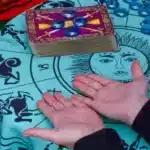Ever found yourself staring at your palm, wondering what all those lines mean? Palmistry, also known as chiromancy, is the ancient art of interpreting the lines and shapes on our hands to gain insights into our personalities, potentials, and destinies.
One of the most significant lines is the life line, which represents our vitality, energy, and overall well-being. But what does it mean when this important line appears broken? Let’s dive into the fascinating world of palmistry to explore the implications of a broken life line.
Table of Contents
What is a Life Line?
The life line, which starts just below the thumb and curves down towards the wrist, is one of the most iconic lines on the palm. Contrary to popular belief, it doesn’t predict how long you’ll live but instead indicates your overall vitality and resilience.
A strong, unbroken life line suggests robust health and energy. Palm readers often look at this line first to get a sense of your physical and emotional well-being.
Where is the Life Line Located?
Locating the life line is relatively straightforward. It stretches diagonally across the palm, starting from the area between the thumb and index finger and curving downward towards the wrist. Despite its name, the life line doesn’t terminate at the end of life but symbolizes quality of life, vitality, and overall health. Its length, depth, and curvature can vary significantly from person to person, offering unique clues about their temperament, resilience, and predisposition to specific health conditions.
Main Types of Life Lines
Your palm holds secrets beyond measure, each line telling a unique story of your past, present, and future. Among these enigmatic markings, the life line stands out as a beacon of vitality and resilience, guiding palm readers to insights about your physical and emotional well-being. But within this line lie nuances and variations that offer deeper layers of interpretation. Let’s explore the main life line types and unravel their mysteries.
Short Life Line
A short life line, extending only a short distance from the base of the palm, often signifies a cautious and pragmatic approach to life. Those with this type of life line tend to prioritize stability and security, seeking comfort in familiar routines rather than venturing into the unknown. Grounded and practical, they navigate life’s challenges with a steady hand and a keen eye for practical solutions.
Long Life Line
In contrast, a long life line suggests boundless energy, resilience, and a zest for life’s adventures. Individuals with a long life line are often described as vibrant, energetic, and unafraid to take risks. They embrace new experiences enthusiastically, viewing challenges as opportunities for growth rather than obstacles to avoid. Their insatiable curiosity and thirst for life propel them forward on a journey of self-discovery and fulfillment.
Curved Life Line
A curved life line, gently arcing across the palm, reflects flexibility and adaptability in the face of life’s twists and turns. Those with a curved life line are versatile and open-minded, able to navigate change gracefully and easily. They view obstacles as opportunities for growth, embracing each new challenge with optimism and resilience. Their ability to bend without breaking serves them well on life’s journey, allowing them to weather storms with grace and resilience.
Forked Life Line
A forked line, where the line splits into two or more branches towards the end, indicates a multifaceted personality with diverse interests and talents. Individuals with a forked life line may excel in multiple areas or pursue varied career paths simultaneously. They possess a versatile skill set and a natural curiosity that drives them to explore new horizons. Their ability to easily balance different aspects of their lives makes them adept at juggling competing priorities and enthusiastically pursuing their passions.
Intersecting Life Line
An intersecting life line, where other lines cross or intersect the Life Line, suggests significant life events or transitions. These intersections may represent challenges, opportunities, or turning points in the individual’s life journey. Palm readers interpret the location and nature of these intersections to provide insights into specific aspects of the person’s life, such as relationships, career changes, or personal growth. Each intersection marks growth and transformation, guiding the individual to self-discovery and fulfillment.
Broken Life Line
Finally, the broken life line, the subject of our inquiry, presents a unique challenge for interpretation. When the life line appears broken or fragmented, it can evoke concerns about one’s health and well-being. However, it’s essential to approach this phenomenon with an open mind and a discerning eye, considering the various factors that may influence its interpretation.
Is it Dangerous to Have a Broken Life Line?
The idea of a broken Life Line may sound ominous, but it’s essential to remember that palmistry is not a precise science. Interpretations can vary widely among practitioners, and a broken life line doesn’t necessarily spell disaster. While it may indicate periods of illness, injury, or emotional upheaval, it doesn’t necessarily imply a life-threatening situation. Instead, it could signify temporary challenges or transitions contributing to personal growth and resilience.
Is a Broken Life Line Common?
Broken life lines are not uncommon, and many individuals have them without experiencing any significant health issues. The appearance of a broken Life Line may be temporary, reflecting transient obstacles or changes in one’s life path. It’s crucial to consider the overall context of the palm and other lines when interpreting the significance of a broken life line. Rather than fixating on the perceived negative implications, focus on maintaining your physical and emotional well-being, seeking support from loved ones, and adopting healthy lifestyle habits.
What If You Have a Broken Life Line?
If you discover a broken life line on your palm, don’t panic. Remember that palmistry is just one tool for self-reflection and personal insight; its interpretations are not set in stone. Instead of dwelling on a broken life line’s potential challenges, focus on proactive measures to support your health and well-being. Take steps to address any underlying health concerns, seek guidance from healthcare professionals, and prioritize self-care practices that promote resilience and vitality.
Questions to Ask During a Palm Reading with a Broken Life Line
If you’re consulting a palm reader about a broken life line, consider asking the following questions to gain a deeper understanding of its significance:
- What is the overall health prognosis indicated by the broken life line?
- Are there any specific health issues or concerns I should be aware of?
- How can I promote healing and vitality despite a broken life line?
- Are there any lifestyle changes or practices that can help mitigate the potential challenges of a broken life line?
- What other aspects of my palm should I focus on to better understand my health and well-being?
Conclusion
While a broken life line may raise questions and concerns, it’s essential to approach palmistry with an open mind and a healthy dose of skepticism. Remember that interpretations can vary, and palmistry is not a definitive guide to your destiny. Instead of fixating on individual lines or markings, focus on the bigger picture – your overall health, happiness, and fulfillment.
Embrace life’s challenges as opportunities for growth, and cultivate resilience, positivity, and self-compassion. With grace and determination, you can navigate the twists and turns of life’s journey, empowered by the knowledge that your fate lies in your own hands.











